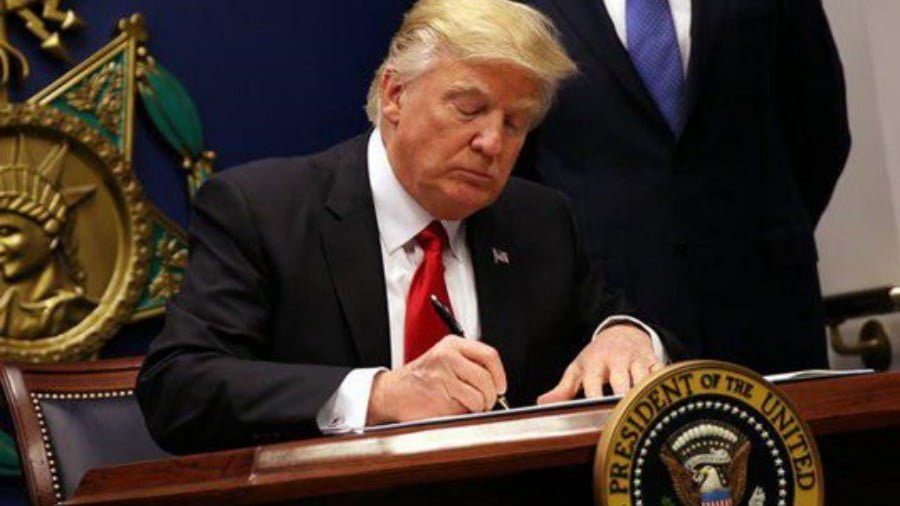US Vulnerabilities in Domestic and Foreign Policy
The new round of confrontation between Russia and the West [i] forces us to think about how to damage opponents without resorting to an armed conflict. Since the main instigator of the anti-Russian campaign is the United States, it makes sense to consider the weaknesses of this state in order to exploit them at the global geopolitical level.
Some problems in the United States have nothing to do with the international agenda and reflect the internal political struggle and the general degradation of political culture. For example, the policy of LGBTising American society has reached such a peak that the state bodies of this country already say that the words “mom” and “dad” are offensive, which, of course, is perceived by the conservative part of society as unacceptable actions. [ii]
The struggle between supporters of traditional values and sodomites is going on in the legislative and judicial authorities of various states. Republicans are exploiting this topic to take revenge in the US midterm elections. Polarisation may further lead to the radicalisation of a number of social movements, many of which represent militarised organisations. And this is fraught with an open armed conflict within the country on an ideological principle.
The American economy is also not in the best condition. Back in December last year, consumer price inflation was 6.8%, which showed the fastest pace in the last 40 years. Inflation has already reached a multi-year high, and in addition, the country is experiencing a bubble in the stock and housing market caused by excessive bond purchases by the Federal Reserve System.
The well-known economist Desmond Lachman, who previously worked at the IMF, pointed out: the last thing Mr. Biden needs ahead of this year’s midterm elections is for the bubbles in the US stock and housing market to burst. Nevertheless, this is exactly what could happen if the Fed is really forced to raise interest rates in order to kill the inflationary dragon, which is now being given an additional boost by high oil prices.
This seems to be especially relevant given that the bubbles in both the stock market and the housing market were based on the assumption that interest rates would remain at their current ultra-low levels forever. [iii]
Given that the Russian-Ukrainian situation is unlikely to be resolved in the near future, there is every chance that oil prices will remain high in the foreseeable future, especially if sanctions are imposed on the Russian oil sector. This will leave the Federal Reserve with little choice but to press the brakes on monetary policy to prevent domestic inflation expectations from weakening. [iv]
The Biden government is also harshly criticised for the fact that new laws related to the allocation of budget funds to contain China and support the Pentagon will direct tens of billions of dollars not for education, health care and other social tasks. [v]
Territorial disputes between the United States and its neighbours can also be an effective means to shift attention and create confusion in partnerships within NATO members.
Although there is a well-known saying that the United States has only Mexico and fish among its neighbours, Canada represents exactly the case when there are precedents for territorial disputes. And the degradation of the economy may increase these tensions, since the zones claimed by the two states are of interest for fishing and seafood, and also contain significant amounts of energy resources.
In total, there are five marine areas where Canada and the United States disagree on the question of who they belong to. The deterioration of relations between countries can happen just because of them.
The first disputed section is the Strait of Juan de Fuca, which separates Vancouver Island in British Columbia (Canada) from the Olympic Peninsula in Washington State (USA). The border between the two countries runs right in the middle of the strait. Both countries agree that the border here should be at an equal distance. But each side uses slightly different base points, which leads to slight differences in the border line.
In addition, the government of the province of British Columbia rejected both the Canadian and American borders, as well as the entire principle of equidistance. It asserts the principle of natural continuation, which states that an underwater canyon (also called Juan de Fuca) is a suitable boundary. This approach speaks in favour of British Columbia, but the Canadian government does not want to abandon the principle of equidistance, which can cost it dearly in other areas.
At the Dixon Entrance, the opposite is true. To the north of it is Prince of Wales Island. Despite its royal name, the island is part of the United States. To the south of Dixon Entrance is the Canadian archipelago of Haida Gwaii, known until 2010 as the Queen Charlotte Islands.
The waters between them are rich in fish, attracting predators, albatrosses and, of course, people. Interestingly, the current conflict has its roots in the confrontation between the Russian Empire and Great Britain. Today’s border between Alaska and Canada corresponds to the St. Petersburg Treaty of 1825. This agreement between Russia and Great Britain drew a line between the interests of the two countries in the north-west of North America. It set 54°40′ north latitude as the southern border of Russian America.
The dispute was later settled by international arbitration in 1903. The current land border is 35 miles (56 km) east of where the ocean meets the coast, somewhere in the middle between the lines claimed by both sides.
Canadians, however, remained dissatisfied. If the border had been a little further in their favour, they would have had direct maritime access to the Yukon gold fields. The arbitration also determined the maritime border of Alaska with Canada. The so-called A-B line ran from Cape Muzon – the southernmost point of Dall Island, the southernmost island of Alaska – east to the mainland. This left most of the Dixon Entrance on the Canadian side of the line.
But Americans saw it differently. They believed that the A-B line was related to the land border; the sea border ran well south of the line. This cuts the Dixon Entrance in two: the northern one leads to the US, the southern one leads to Canada.
Both governments still hold these views. One of the reasons why this issue is so difficult to solve is the Pacific salmon in the area, which goes to spawn every year.
Relatively recently, in the 1990s, competition between Canadian and American fishermen in this area escalated into the so-called “salmon wars”, when both sides from time to time arrested each other’s crews. In 1997, the situation reached a climax when Canadian fishermen blocked an Alaskan ferry, effectively holding its passengers hostage for three days. The situation is less tense now, but the main problem has not been solved.
Also in the Beaufort Sea there is a disputed wedge-shaped area north of where the border between Alaska and the Yukon Territory faces the sea. This land border runs along the 141st western meridian, as agreed in the St. Petersburg Treaty of 1825 between Russia and Great Britain.
Canada believes that it is necessary to follow this line 200 nautical miles (370 km) north into the sea, and this is the maritime border. But the US argues that the maritime boundary should be perpendicular to the coastline when it goes out to sea. The difference is an area of about 8,100 square miles (21,000 square kilometres).
The dispute flares up because of significant oil and gas reserves hidden under ice and water. According to the National Energy Council of Canada, the wedge can contain up to 1.7 billion cubic meters of gas and 1 billion cubic meters of oil – enough to meet the country’s energy needs for many years. And in a few years, these reserves may become more accessible as the ice retreats due to climate change.
There is also the Northwest Passage, which represents a route through various channels through the vast northern archipelago, which has been frozen for many months. Over the past few decades, climate change and the resulting reduction in sea ice have made Canada’s northern canals more convenient for navigation. In 2007, a commercial vessel completed the journey without the help of an icebreaker, which happened for the first time in history.
If the northern route could pass supertankers and other vessels too large for the Panama Canal, it would significantly reduce their only current option: traveling around Cape Horn, at the southern tip of South America. As the overall temperature on Earth continues to rise, the Northwest Passage will become increasingly suitable for sea transportation, even if only in summer. This means that the territorial dispute over the Northwest Passage is likely to flare up again.
For Canada, the problem is pretty clear: any potential waterway opening up to international shipping will pass through Canadian waters over which the country exercises full sovereignty, meaning Canada can grant access or charge tolls at its discretion.
However, the United States and a number of other countries argue that a viable Northwest Passage would de jure be an international strait open to transit passage without restrictions or compensation.
In 1969, the American oil tanker SS Manhattan completed the passage without asking for prior permission from the Canadians, and to bring the matter to an end, the US Coast Guard icebreaker Polar Sea did the same in 1985. Despite the fact that the last vessel was allowed to be searched by the Canadian Coast Guard, public opinion in Canada was enraged, and a diplomatic scandal broke out.
In 1986, Canada confirmed its sovereignty over the Northwest Passage, but the United States refused to recognise this claim. To defuse the situation, both countries signed an agreement on cooperation in the Arctic in 1988, which did not address the issue of sovereignty as such, but clarified some practical issues.
According to the law of the sea, vessels in transit passage do not need a permit to pass, but at the same time they cannot engage in research. The agreement assumed that the vessels of the US Coast Guard and the US Navy would always be considered as conducting research, so it would always be necessary to request permission for transit.
The contract was valid for about ten years. At the end of 2005, photographs of the American ship Charlotte at the North Pole were published. Of course, no one asked permission for passage from Canada. Canada’s response was that it decided to no longer use the term “Northwest Passage”, but designated the area as “Canada’s Inland Waters”.
The United States adheres to its interpretation of international law and reserves the right to treat Canada’s internal waters as international waters instead. By the way, they defend this position both on the South China Sea and on other areas claimed by other countries, calling it the “right to free navigation”.
Another point of conflict is Machias Seal Island off the coast of Maine. It is less than 10 miles off the coast of Maine. The Canadians established their presence there under the guise of the work of lighthouse keepers. The US considers it its own. In 2002, Canada allowed its fishermen to fish there in the summer, which led to a direct conflict with fishermen from Maine.
The rights of the indigenous Indian population, including compensation claims, the possibility of secession of Texas, as well as the growth of separatist sentiments in rich states (this was already the case in California during the Great Depression, when the state government imposed a ban on entry into it and even surrounded it with a fence with barbed wire) – also present interesting cases that cannot be discounted. And finally, the huge Latin American population, which is increasing rapidly, especially in the south. A reminder of the annexation of part of Mexico by the United States would be very useful among the Latin American community.
[I] https://russtrat.ru/analytics/26-fevralya-2022-0010-8991
[ii] https://c-fam.org/friday_fax/biden-admin-says-mother-and-father-are-offensive/
[iii] https://www.19fortyfive.com/2021/12/americas-growing-inflation-problem-who-is-to-blame/
[iv] https://www.19fortyfive.com/2022/02/joe-bidens-next-economic-nightmare-an-oil-price-shock/
[v] https://fpif.org/the-u-s-competes-with-china-at-what-cost/







